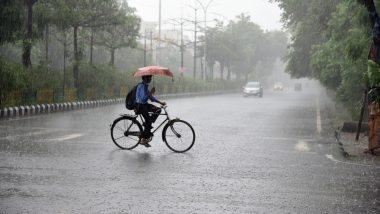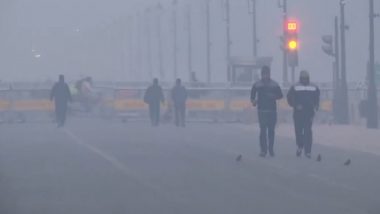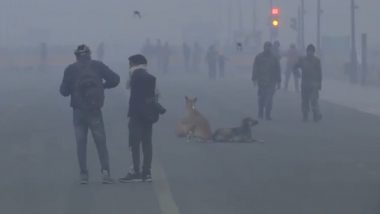New Delhi, November 3: Parts of Delhi-NCR received light showers on Saturday evening, bringing much-needed respite to people of the region amid severe pollution and worsening air quality levels. Light rain was reported in Dwarka, Rohini, Noida and Lodhi Road areas. As the wind speed increased in Delhi and its neighbouring areas due to a western disturbance, pollution levels dropped marginally on Saturday. According to a tweet by ANI, the air quality index in Bawana at 492, ITO crossing at 487 and Ashok Vihar at 482. All three fall in the 'Severe' category. Delhi Continues to Reel Under Severe Air Quality, Thick Smog Covers Sky, Respite Likely After November 3.
On Friday, the Delhi-NCR region recorded its worst air quality forcing authorities to shut schools till November 5 and declaring a public health emergency. The higher the AQI value, the greater the level of air pollution and health concerns. An AQI between 0-50 is considered ‘good’, 51-100 ‘satisfactory’, 101-200 ‘moderate’, 201-300 ‘poor’, 301-400 ‘very poor’ and 401-500 ‘severe’. Above 500 falls in the ‘severe plus’ category. Delhi Pollution Update: Public Health Emergency Declared in NCR as Air Quality Deteriorates.
According to weather agencies, a western disturbance is set to reach Delhi on November 3 and is likely to increase the wind speed to nearly 20 km per hour. As the wind gains pace in the Delhi-NCR region, it will help disperse the air pollutants which have accumulated over the region. Weather experts believe that there is a significant improvement in wind speed and it will increase gradually from Sunday. On Saturday, the overall air quality index (AQI) was at 402 at 8 pm, as against 484 on Friday, following light winds and scattered rainfall.
As per details by government air quality monitor SAFAR, the share of stubble burning in Delhi’s pollution also reduced from 44 per cent on Friday, the season’s highest, to 17 per cent on Saturday, following light winds and scattered rainfall. The AQI dipped to average of 399 for the past 24 hours, which is in the “very poor” category and a shade better than the ‘severe’ category,according to the Central Pollution Control Board’s (CPCB) 4 pm bulletin on Saturday.
Toxic Haze Engulfs Punjab and Haryana
Apart from Delhi-NCR, a blanket of haze engulfed Punjab and Haryana too as over 22,000 cases of stubble burning had been witnessed in Punjab and more than 4,200 incidents in Haryana in the recent days, reports said. Several districts reported air quality index in “severe” (101-500) and “very poor” (301-400) categories.
The thick blanket of haze reduced visibility substantially in most parts of the two states. According to a report by PTI, in Punjab, the air quality fell in “poor” and “very poor” categories. Bathinda recorded air quality index at 318, followed by Ludhiana at 302.
Air Quality Severe in Parts of Uttar Pradesh
The pollution levels in Lucknow in Uttar Pradesh and Patna in Bihar were worse than in Delhi, reports said. Th Central Pollution Control Board’s (CPCB) in its Saturday weather bulletin stated that 13 cities of the country had an average Air Quality Index (AQI) above 400, which falls in “severe” category, with seven of them in Uttar Pradesh, five in Haryana and one in Bihar. On Sunday, the air quality index at Lalbagh area in Lucknow was at 419 and that of Talkatora District Industries Center area was at 433 on Air Quality Index. Both in 'Severe' category.
In Uttar Pradesh, Ghaziabad had the worst average AQI of 453 on Saturday, followed by Bulandshahr (446), Hapur (444), Greater Noida (438), Baghpat (435), Noida (432), Lucknow (422), Kanpur (379), Meerut (371) and Varanasi (328), the CPCB data stated.
If the AQI falls in “severe” category, it affects healthy people and severely impacts those with prevailing diseases. Also, “very poor” air quality can cause respiratory illness on prolonged exposure.
(The above story first appeared on LatestLY on Nov 03, 2019 08:38 AM IST. For more news and updates on politics, world, sports, entertainment and lifestyle, log on to our website latestly.com).













 Quickly
Quickly




















